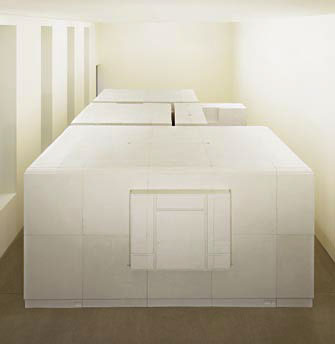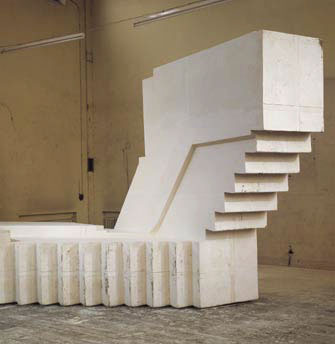 |
Untitled (Apartment), 2001. Mixed media, 114 x 443 5/8 x 245 5/8 inches. Deutsche Guggenheim Berlin. Photo by Gautier Deblonde. |
 |

  
|
 |
 |
 |
Untitled (Basement), 2001. Mixed media, 112 1/4 x 436 5/8 x 241 3/4 inches. Deutsche Guggenheim Berlin. Photo by Gautier Deblonde. |
 |

  
|
 |
|
 |
The British artist Rachel Whiteread has received critical acclaim for creating a unique body of sculpture in which ordinary domestic objects and architectural spaces are transformed into poetic, thought-provoking works of art. In the late 1980s Whiteread began casting sculptures from household items including beds, sinks, baths, and wardrobes, emphasizing the private aspects of domestic life and reflecting the human body in symbolic terms. Using such industrial materials as plaster, concrete, rubber, and polystyrene, Whiteread typically cast the space underneath, around, or inside the objects, creating negative impressions of the items she worked with. Her familiar yet strange forms, which record the shape and surface of the original objects in detail, but not their physical presence, function like a death mask, often evoking feelings of absence and loss and conjuring up various personal memories and associations for the viewer.
Over time Whiteread expanded the scope of her program to include casts of larger architectonic spaces. In 1993, the artist created her first public sculpture, titled House, a concrete cast of the interior spaces in a Victorian, working-class home. Located on a street scheduled for demolition, the off-white structure appeared as a ghost of its original form and drew attention to the consequences of gentrification in East London occurring at the time. In October 2000, Whiteread unveiled her Holocaust Memorial in Vienna. Devoted to the 65,000 Austrian Jews killed during World War II, this monolithic project—an impenetrable, inside-out library—alludes to Nazi book burnings yet also makes symbolic reference to the "people of the book," remarking on not only the Holocaust, but the larger history of the Jewish people.
For Deutsche Guggenheim Berlin, Whiteread has created two new sculptures from a London building she recently purchased to become her new home and studio. Devoid of architectural flourish, Whiteread's Untitled (Apartment) comprises a series of small nondescript rooms, suggestive of the low-income, standardized housing that developed after World War II, as Europe rushed to rebuild itself. For Untitled (Basement), Whiteread cast a staircase, which she reoriented by setting it on its side, to create a sense of motion, such that the sculpture appears to bend and rise of its own will. Embodying the generic nature of much postwar architecture, both works, with their smooth, unadulterated surfaces, emphasize the simple geometry of the structures from which they come, recalling 1960s Minimalist sculpture. Throughout its history Whiteread's building has shown signs of a fluid identity, readily changing functions over time, existing as first a synagogue, then a textile merchant's warehouse, and soon the artist's new residence and studio. Echoing the transient spirit of postwar culture, her two new works blur distinctions between private and public, past and present, as well as religious and secular, reflecting the aesthetic and economic concerns of the time.
|